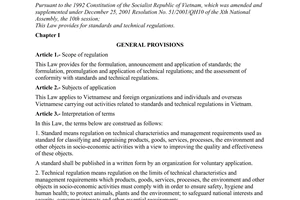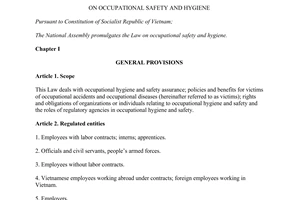Nội dung toàn văn Circular 27/2016/TT-BYT national technical regulation vibration permissible levels vibration in the workplace
|
MINISTRY OF
HEALTH |
SOCIALIST
REPUBLIC OF VIETNAM |
|
No. 27/2016/TT-BYT |
Hanoi, June 30, 2016 |
CIRCULAR
NATIONAL TECHNICAL REGULATION ON VIBRATION - PERMISSIBLE LEVELS OF VIBRATION IN THE WORKPLACE
Pursuant to the Law No.84/2015/QH13 on Occupational Hygiene and Safety dated June 25, 2015;
Pursuant to the Law No.68/2006/QH13 on Technical regulations and standards dated June 29, 2006;
Pursuant to the Government's Decree No. 127/2007/ND-CP dated August 01, 2007 detailing a number of articles of the Law on Technical regulations and standards;
Pursuant to the Government’s Decree No. 63/2012/ND-CP dated August 31, 2012 defining the functions, rights, obligations and organizational structure of the Ministry of Health;
Upon request of the Director of Health Environment Management Agency;
The Minister of Health hereby issues this Circular stipulating the national technical regulation on vibration - permissible levels of vibration in the workplace.
Article 1. National Technical Regulation on Vibration
The national technical regulation on vibration - permissible levels of vibration in the workplace is enclosed with this Circular.
Article 2. Effect
This Circular enters into force from December 01, 2016.
Article 3. Implementation
The Director of Health Environment Management Agency, Directors and Directors General of Departments and General Departments affiliated to the Ministry of Health , heads of affiliates, Directors of Departments of Health of provinces and Heads of Health Agencies shall be responsible for implementing this Circular./.
|
|
PP. MINISTER |
QCVN 27:2016/BYT
NATIONAL TECHNICAL REGULATION ON VIBRATION - PERMISSIBLE LEVELS OF VIBRATION IN THE WORKPLACE
Preface
QCVN 27:2016/BYT is compiled by the Drafting Board of the National Technical Regulation on Occupational Hygiene, approved by the Health Environment Management Agency and issued together with the Circular No.27/2016/TT-BYT dated June 30, 2016 by the Minister of Health.
NATIONAL TECHNICAL REGULATION ON VIBRATION - PERMISSIBLE LEVELS OF VIBRATION IN THE WORKPLACE
I. GENERAL PROVISIONS
1. Scope of governing
This Regulation stipulates the permissible level of vibration in the workplace that workers are exposed to.
2. Subjects of application
This Regulation applies to environmental authorities; entities conducting environmental monitoring and entities producing vibration in the workplace.
3. Interpretation
For the purpose of this Regulation, terms herein shall be construed as follows:
3.1. Vibration is a mechanical oscillation producing by engine or tools, including harmonic oscillation and anharmonic oscillation.
3.2. Vibration frequency is the number of oscillation in a certain period of time, expressed in Hertz (Hz).
3.3. Vibration periodic is a length of time during which an oscillation finishes.
3.4. Vibration amplitude is the maximum displacement measured from the equilibrium point of an oscillation. Vibration amplitude is expressed in mm, cm or m.
3.5. Vibration velocity is a particular velocity vector representing the direction and speed of an oscillator. Vibration velocity is expressed mm/s; cm/s and m/s.
3.6. Vibration acceleration is a particular vector representing the direction and velocity of an oscillator. Vibration acceleration is expressed in mm/s2, cm/s2 and m/s2.
3.7. Whole-body vibration refers to any vibration transferred to human body. There are two type of vibration: vertical vibration and horizontal vibration.
3.8. Hand-Arm vibration refers to any vibration transferred to a part of the human body when contacting with the source of vibration.
3.9. Permissible vibrations are determined by a perpendicular coordinate system attached to human body. A perpendicular coordinate system has 03 axes:
z- Vertical axis, perpendicular to the ground, from the human foot to head
X – Horizontal axis, from the human back to chest.
y- Horizontal axis, from the right shoulder to the left shoulder
II. TECHNICAL REGULATION
1. Hand-Arm vibration
1.1. Permissible acceleration and velocity in a range of frequencies are presented in table 1.
Table 11. Average acceleration and velocity in octave bands
|
Frequency bands (Hz) |
Permissible value |
|
|
Acceleration (m/s2) |
Velocity (m/s) 10-2 |
|
|
8 (5.6-11.2) |
1.4 |
2.8 |
|
16 (11.2-22.4) |
1.4 |
1.4 |
|
31.5 (22.4-45) |
2.7 |
1.4 |
|
63 (45-90) |
5.4 |
1.4 |
|
125 (90-180) |
10.7 |
1.4 |
|
250 (180-355) |
21.3 |
1.4 |
|
500 (355-700) |
42.5 |
1.4 |
|
1,000 (700-1,400) |
85.0 |
1.4 |
1.2. Adjusted permissible acceleration and velocity in octave band frequencies depends on the exposure duration and are presented in Table 2
Table 2. Adjusted permissible acceleration and velocity in octave band frequencies by the exposure duration
|
Exposure duration, minute |
Permissible value |
|
|
Acceleration (m/s2) |
Velocity (m/s) |
|
|
480 |
1.4 |
1.4.10-2 |
|
240 |
2.0 |
2.0.10-2 |
|
120 |
2.8 |
2.8.10-2 |
|
60 |
3.9 |
3.9.10-2 |
|
30 |
5.6 |
5.6.10-2 |
Notes: The maximum permissible vibration shall not exceed he permissible vibration value in 30-minute exposure duration (refer to Table 2).
1.3. Adjusted permissible acceleration and velocity: Within 8 hours (480 minutes) of contact, the adjusted velocity and acceleration of vibration at other frequency bands shall not exceed 4 cm/s and 4m/s2, respectively.
1.4. Adjusted permissible acceleration and velocity by exposure duration: Where the exposure duration is less than 8 hours per day, the adjusted permissible acceleration and velocity shall be determined by the following function:
![]()
Where:
ahD: the adjusted value (the adjusted permissible velocity or acceleration by exposure duration (t))
ah: the adjusted permissible velocity or acceleration within 08 hours (480 minutes) of working duration.
T: Actual exposure duration, expressed in minute.
The maximum adjusted acceleration and velocity shall not exceed 16m/s2 and 16cm/s, respectively, within 30 minutes of working.
2. Whole-body vibration
2.1. Permissible acceleration and velocity in octave band frequencies are presented in table 3.
Table 3. Permissible acceleration and velocity in octave bands
|
Frequency bands (Hz) |
Acceleration (m/s2) |
Velocity (m/s) |
||
|
Vertical vibration |
Horizontal vibration |
Vertical vibration |
Horizontal vibration |
|
|
1 (0.08-1.4) |
1.10 |
0.39 |
20.0.10-2 |
6.3.10-2 |
|
2 (1.4-2.8) |
0.79 |
0.42 |
7.1.10-2 |
3.6.10-2 |
|
4 (2.8-5.6) |
0.57 |
0.80 |
2.5.10-2 |
3.2.10-2 |
|
8 (5.6-11.2) |
0.60 |
1.62 |
1.3.10-2 |
3.2.10-2 |
|
16 (11.2-22.4) |
1.14 |
3.20 |
1.1.10-2 |
3.2.10-2 |
|
31.5 (22.4-45) |
2.26 |
6.38 |
1.1.10-2 |
3.2.10-2 |
|
63 (45-90) |
4.49 |
12.76 |
1.1.10-2 |
3.2.10-2 |
Note: Either acceleration or velocity is measured when carrying out vibration surveys.
2.2. The adjusted permissible acceleration of vertical vibration (by z axis) and horizontal vibration (x and y axes) shall not exceed 0.54m/s2 and 0.38 m/s2, respectively.
2.3. Different tools and workplace have different acceleration adjusted coefficient by exposure duration.
Type 1: Transportation vibration to which workers at mobile machinery and means of transport are exposed. E.g.: Drivers of trucks and agricultural tractors…
The adjusted permissible acceleration by exposure duration equals (=) the adjusted acceleration multiplied by (x) 1. The adjusted permissible acceleration of vertical vibration (by z axis) and horizontal vibration (x and y axes) shall not exceed 0.54m/s2 and 0.38 m/s2, respectively.
Type 2: Transportation vibration – technology affecting workers in the workplace having machinery and means of transport in a limited area of a production area or mining site. E.g.: Operators of cranes, excavators and mining machines.
The adjusted permissible acceleration by exposure duration equals (=) the adjusted acceleration multiplied by (x) 0.5. The adjusted permissible acceleration of vertical vibration (by z axis) and horizontal vibration (x and y axes) shall not exceed 0.27m/s2 and 0.19 m/s2, respectively.
Type 3: Vibration caused by production activities affecting workers in the location of static machines or transmitting or the workplace where no source of vibration is located. E.g. operating tools and ground of fixed machines used in production
The adjusted permissible acceleration by exposure duration equals (=) the adjusted acceleration multiplied by (x) 0.16. The adjusted permissible acceleration of vertical vibration (by z axis) and horizontal vibration (x and y axes) shall not exceed 0.086m/s2 and 0.06 m/s2, respectively.
III.MEASUREMENT OF VIBRATION
The following standards shall apply to measure the vibration:
1. TCVN 5127 - 90. Hand-Arm vibration –Permissible values and methods of evaluation
2. TCVN 6964 -1:2001 (ISO 2631-1:1997) – Mechanical vibration and shock – Evaluation of human exposure to whole-body vibration.
IV. MANAGEMENT
1. Every facility whose workers contact with vibration shall periodically measure vibration levels in the workplace at least once a year and shall comply with the Labor Code and the Law on Occupational Hygiene and Safety.
2. Employers shall provide sufficient personal protective equipment which is useful in the working environment for their employees.
3. If the vibration level in the workplace exceeds the permissible value, the employer shall take measures for improving the working environment and protecting employees’ health.
V. IMPLEMENTATION
1. This Regulation replaces the standard on vibration included in the standard on occupational hygiene issued under the Minister of Health's Decision No.3733/2002/QD-BYT dated October 10, 2002.
2. The Health Environment Management Agency – Ministry of Health shall take charge and relevant functional authorities to provide instruction and implement this Regulation.
3. According to the actual management requirement, the Health Environment Management Agency shall request the Ministry of Health to make appropriate amendment and supplementation.
4. In case any national standard and international standards on vibration referred to this Regulation is amended, supplemented or replaced, the new one shall prevail.





